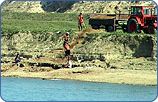
|
|
Agricultural Policies and Pilot Projects
Final Reports - Phase 1
According to the Transboundary Analysis (1999), it is assumed that about half of nutrients discharged in the Danube Basin to the fine web of the river network come from agricultural non-point sources of pollution. For the necessary nutrient pollution reduction from agricultural sources combination of different policy measures are needed. The Project focuses on assisting the DRB countries in designing new agricultural point and non-point source pollution control policies and legislation towards sustainable land use and agricultural practices ("sustainable agriculture"), as well as compliance and enforcement plans in line with the existing and emerging (driven by EU accession process) national legislation. Within the Phase 1 activities, the agricultural policies and their enforcement in DRB countries was analysed and an inventory of pesticide and fertilizers was prepared and use assessed. The existing situation in policy development and implementation of Best Agricultural Practice (BAP) in Danube countries was reviewed and analysed, and a concept for introduction of BAP was developed. Guidelines for manure handling were developed in national languages. In Phase 2 of the Project policy and legal recommendations will be developed for DRB governments to reinforce the introduction of BAP and to optimize the use of agrochemicals. The main focus of this assistance is to identify for each DRB country the main administrative, institutional and funding deficiencies and to develop priority reform measures for policies which are expected to best support the integration of environmental concerns into farm management (BAP), including improvements in the handling of manure and sludge from livestock operations, minimization of the use of chemical fertilizers and pesticides, promotion of improved tillage methods, management of restored wetlands, creation of buffer zones and farmer education and outreach activities. |






